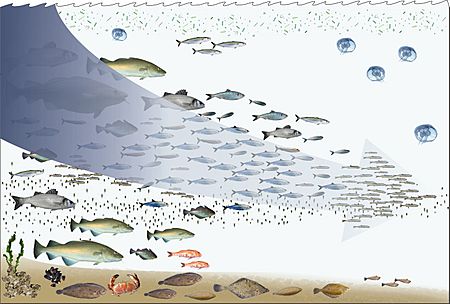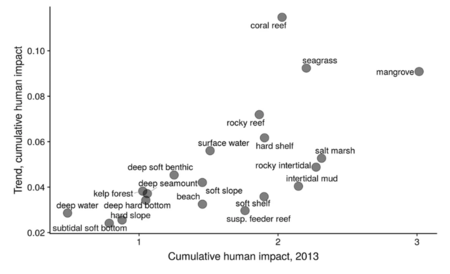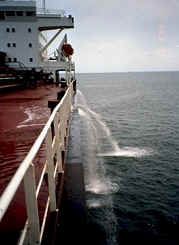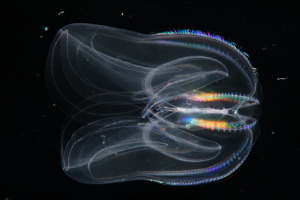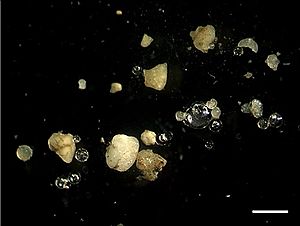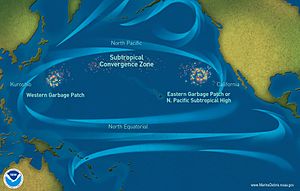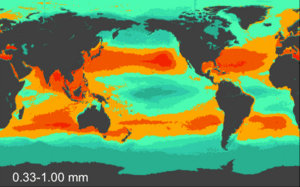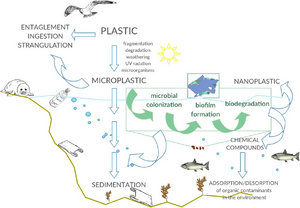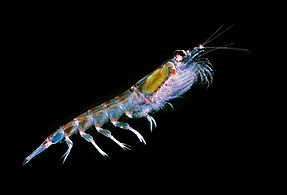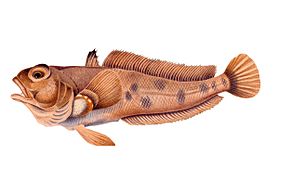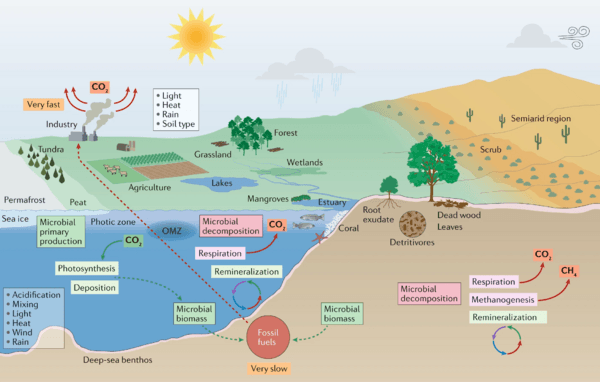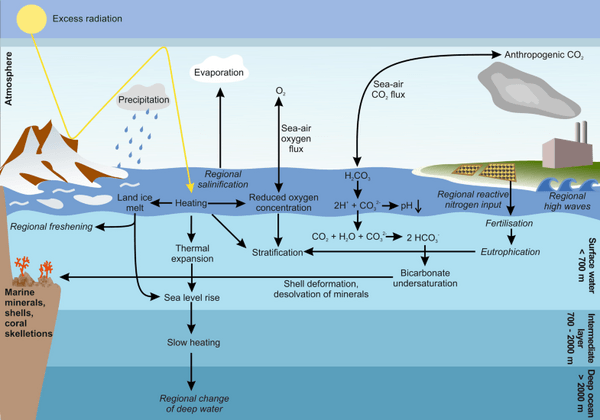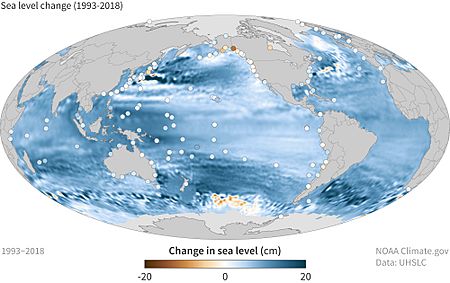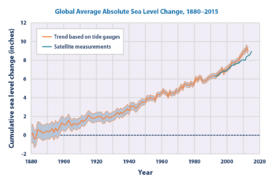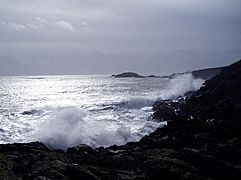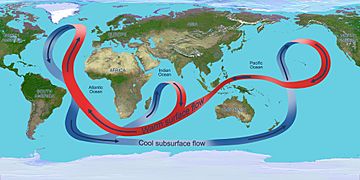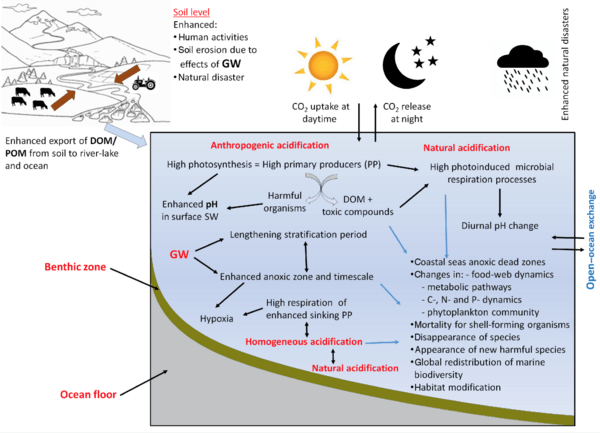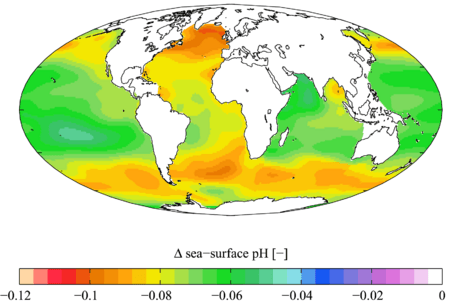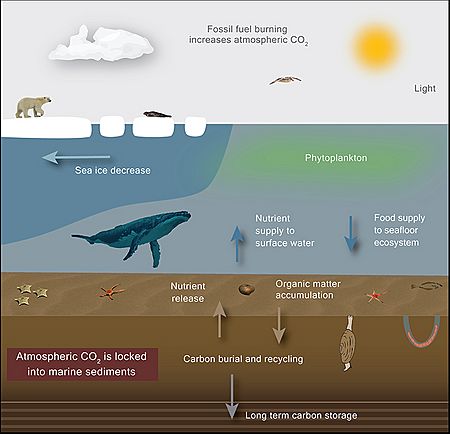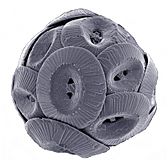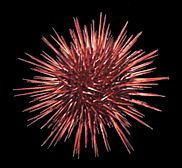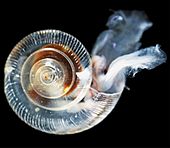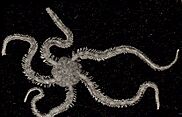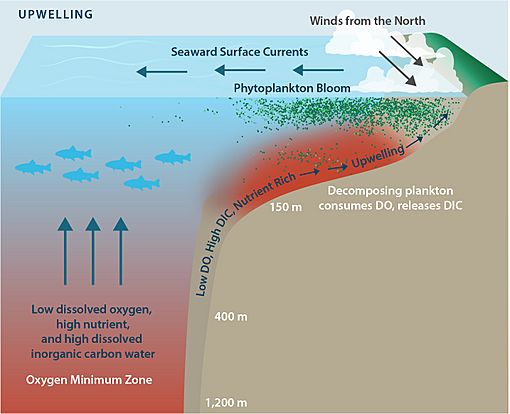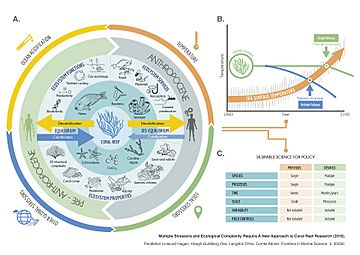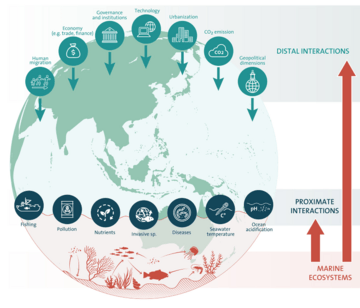Human impact on marine life facts for kids
Human activities are changing the ocean and the amazing creatures that live there. Things like too much fishing, losing important homes for marine life, new species arriving where they don't belong, and pollution are all causing problems. The ocean is also getting warmer and more acidic.
These changes affect ocean ecosystems and the food chains within them. Scientists are still learning about all the possible long-term effects on the many different kinds of life in the sea.
The IPCC (a group of experts on climate change) reported in 2019 that since 1950, many ocean species have moved to new areas or changed their seasonal activities. This is happening because the ocean is getting warmer, sea ice is changing, and there are new chemical changes like less oxygen in their homes.
It's thought that only about 13% of the ocean is still truly wild, mostly in the open sea, not near coasts.
Contents
Too Much Fishing
Overfishing means catching too many fish, faster than they can reproduce. A 2018 report said that one-third of the world's fish stocks are being overfished. Also, many people believe that illegal fishing happens in most fisheries, making up to 30% of the total catch in some important areas.
When people overfish the big, valuable fish, the average size and type of fish caught changes. This is called "fishing down the food web." It means we're catching fewer big fish that are high up in the food chain, and more smaller fish or other creatures that are lower down.
Losing Ocean Homes
Coastal areas are especially hurt by human activities. Important habitats like seagrass meadows, mangrove forests, and coral reefs are shrinking around the world because of human actions.
Coral reefs are some of the most diverse and productive places on Earth. But about one-fifth of them have been lost recently due to human disturbances. Corals rely on tiny marine microorganisms to get and reuse nutrients in clear, nutrient-poor waters. However, these same microorganisms can also make coral reef problems worse, affecting the ocean's natural cycles and food webs. We need to understand these tiny interactions better to save coral reefs.
Seagrass meadows have lost about 30,000 square kilometers in recent decades. Seagrass helps the ocean in many ways, like recycling nutrients and providing food and homes for many marine animals, including endangered dugongs, manatees, and green turtles. They also help coral reef fish.
One-fifth of the world's mangrove forests have also been lost since 1980. Kelp forests are mainly threatened by overfishing, which removes the animals that eat sea urchins. Without these predators, sea urchins can multiply and destroy the kelp.
New Species Arriving
An invasive species is a plant or animal that isn't native to a place but spreads so much it harms the environment, economy, or human health. In 2008, scientists found that shipping was the main way invasive species spread in the ocean. Ships carry marine organisms in two main ways: on their hulls (the outside of the ship) and in their ballast water.
Ballast water is water taken on by ships in one area and released in another port. This water can carry unwanted marine life. For example, zebra mussels, which are from the Black, Caspian, and Azov seas, probably came to the Great Lakes in ballast water from a ship.
One of the worst cases of an invasive species causing harm was a type of jellyfish called Mnemiopsis leidyi. This comb jellyfish spread to many estuaries around the world after being introduced to the Black Sea in 1982, likely through ballast water. The jellyfish population grew very fast. By 1988, it was destroying the local fishing industry. The amount of fish caught dropped hugely. Now that the jellyfish have eaten most of the tiny animals (zooplankton), including fish larvae, their numbers have fallen, but they still control the ecosystem.
Invasive species can take over areas, spread new diseases, change the underwater landscape, and make it hard for native species to find food. In the US alone, invasive species cause about $138 billion in lost money and management costs each year.
Ocean Pollution
Nutrient Pollution
Nutrient pollution is a main cause of "dead zones" in the ocean. This happens when too many nutrients, like nitrates or phosphates, get into the water, usually from human activities. These extra nutrients make algae grow very fast. When the algae die, they sink and are eaten by bacteria. This process uses up a lot of oxygen in the water, creating areas with very low oxygen levels, called "dead zones." Marine life either dies or has to leave these areas.
There are five main sources of nutrient pollution:
- Sewage: Human waste from cities can get into waterways through storms, leaks, or direct dumping.
- Farming: Chemical fertilizers used in farming can wash into rivers and streams, adding too much nitrogen and phosphorus. Animal waste from large farms can also do this.
- Stormwater: Rainwater running off homes and paved areas can pick up nutrients and fertilizers and carry them to the ocean.
- Aquaculture: This is farming aquatic animals. Their waste and uneaten food add extra nutrients to the water around them.
Toxic Chemicals
Toxic chemicals can stick to tiny particles in the water. These particles are then eaten by small ocean creatures like plankton and bottom-dwelling animals. This means the toxins get more and more concentrated as they move up the food chain. Many chemicals also use up oxygen, making some coastal areas (estuaries) have no oxygen. Pesticides and toxic metals also get into ocean food webs, harming marine life. Since many animal feeds contain fish, these toxins can even transfer back to farmed land animals and then to humans.
Tiny ocean plants called phytoplankton have increased in coastal waters over the last century. This might be because of more nutrients running off the land. However, in the open ocean, phytoplankton have recently decreased. This could be due to warming surface temperatures, which prevent nutrients from deeper waters from reaching the surface where phytoplankton live.
Plastic Pollution
Over 300 million tons of plastic are made every year, and half of it is used for single-use items like cups and bags. At least 14 million tons of plastic end up in the oceans every year. It's estimated that about 150 million metric tons of plastic are already in our oceans. Plastic makes up 80% of all trash in the ocean, from the surface to the deep seafloor.
Because plastic is light, much of it floats near the surface. Huge "garbage patches" form in areas called gyres, which are circular ocean currents. There are five main ocean gyres, and each has a significant garbage patch.
Larger plastic pieces can be eaten by marine animals like seabirds, whales, fish, and turtles. This fills their stomachs, making them feel full even though they get no nutrition, which can lead to starvation. Animals can also get tangled in plastic trash and suffocate.
The biggest threat from ocean plastic pollution comes from microplastics. These are tiny plastic fragments, some made small on purpose (like microbeads), and others that break down from larger plastic waste. When plastic enters the ocean, sunlight, temperature, waves, and wind break it into pieces smaller than five millimeters. Even tiny organisms can eat plastic debris and break it down further. For example, a type of tiny shrimp called Orchestia gammarellus can shred a single plastic bag into 1.75 million microscopic pieces! Even though it's broken down, plastic doesn't biodegrade. About 90% of the plastic in the open ocean is microplastic.
These microplastics are often eaten by tiny organisms at the bottom of the food chain, like plankton and fish larvae. This means the plastic gets more concentrated as it moves up the food chain, eventually reaching fish that humans eat. Plastics are made with toxic chemicals, which then enter the marine food chain.
Noise Pollution
The ocean has natural sounds that marine animals have used for thousands of years to find mates, avoid predators, and travel. But human activities have made the ocean much noisier. Ship propellers, industrial fishing, coastal building, oil drilling, and sonar systems all create noise pollution. Shipping alone has increased low-frequency noise by 32 times in major shipping routes over the last 50 years. This drives marine animals away from important breeding and feeding areas.
Sound travels far in the ocean. Human-made noise makes it hard for animals to use sound, causing them stress. This can affect their health, behavior, and even cause death. Loud blasts from seismic surveys (used to find oil and gas) can damage marine animals' ears and cause serious injury. Noise pollution is especially harmful for marine mammals like whales and dolphins that use echolocation to communicate, navigate, feed, and find mates. Too much noise interferes with their ability to do these vital tasks.
Human-Caused Diseases
When ocean environments change quickly, diseases can spread easily. Microbes that cause diseases (like viruses, bacteria, and fungi) can adapt to new ocean conditions much faster than other marine life. This gives them an advantage. Also, these microbes are becoming more common because of aquaculture (fish farming) and human waste polluting the ocean. These activities introduce new germs and extra nutrients, which help the microbes survive.
Some of these microbes are "multi-host pathogens," meaning they can infect and spread among many different species. This is dangerous because they can exist in species that are more resistant to the disease, using them as carriers to keep infecting species that are more vulnerable. This can lead to the complete wipeout of susceptible species.
Climate Change Effects
-
Ocean warming is changing where Antarctic krill live.
Tiny ocean organisms play a big role in the carbon cycle. They help store carbon dioxide (CO2) and also release it when they recycle nutrients. Over millions of years, dead plants and animals turn into fossil fuels. But when humans burn fossil fuels, CO2 is released into the atmosphere much faster than it can be naturally removed. This throws the carbon cycle out of balance, causing atmospheric CO2 levels to rise.
Ocean Warming
Most of the extra heat from global warming goes into the ocean, not the air or land. Scientists realized over 30 years ago that the ocean is a key indicator of human impact on climate change.
Marine animals are moving to cooler parts of the ocean as it warms. For example, a study of 105 marine fish and invertebrate species along the US Northeast coast found that from 1982 to 2015, their average location shifted about 10 miles northward and 20 feet deeper.
Rising ocean temperatures are harming marine ecosystems. For instance, a study on tiny ocean plants (phytoplankton) in the Indian Ocean showed a decline of up to 20% in the last 60 years. The Indian Ocean usually has huge phytoplankton blooms in summer. But increased warming makes the ocean layers separate more, preventing nutrients from mixing up to the surface where sunlight is available for photosynthesis. This limits primary production and disrupts the entire food web in the region. If warming continues, the Indian Ocean could become an "ecological desert."
The Antarctic oscillation is a belt of westerly winds around Antarctica that moves north or south. When it's in its "positive phase," these winds get stronger and move closer to Antarctica. This causes warm deep water to rise up along the Antarctic coast, which has been linked to ice shelves melting from below. This could make large parts of the Antarctic Ice Sheet unstable. This oscillation is currently in its most extreme positive phase in over a thousand years, partly due to increasing greenhouse gases. These big changes are affecting all levels of Antarctic marine food webs. Ocean warming is also changing where Antarctic krill live. Krill are a "keystone species" in the Antarctic, meaning they are super important for the ecosystem and a major food source for marine mammals and birds.
The IPCC (2019) says ocean warming is affecting marine organisms globally, which directly impacts human communities, fisheries, and food production. It's likely there will be a 15% decrease in the number of marine animals and a 21% to 24% decrease in fish catches by the end of this century because of climate change.
A 2020 study reported that by 2050, global warming could spread into the deep ocean seven times faster than it is now, even if greenhouse gas emissions are cut. Warming in these deeper layers could have major consequences for the deep ocean food web, as species will have to move to find temperatures they can survive in.
Rising Sea Levels
Coastal ecosystems face more changes because of rising sea levels. Some ecosystems can move inland as the water rises, but others are blocked by natural or human-made barriers. This "coastal squeeze" can lead to the loss of habitats like mudflats and marshes. Mangroves and tidal marshes can usually grow taller by building up sediment and organic matter. But if sea levels rise too fast, they won't be able to keep up and will be submerged.
Coral, which is important for birds and fish, also needs to grow vertically to stay close to the sea surface and get enough sunlight. So far, it has managed to keep up, but it might not be able to in the future. These ecosystems protect against storms, waves, and tsunamis. Losing them makes the effects of sea level rise worse. Human activities, like building dams, can stop natural adaptation processes by limiting sediment supply to wetlands, leading to the loss of tidal marshes. When seawater moves inland, it can cause problems for land ecosystems, like contaminating their soils. The Bramble Cay melomys is the first known land mammal to go extinct because of rising sea levels.
Ocean Circulation and Saltiness
Ocean salinity is how much dissolved salt is in the ocean. The salt comes from eroded rocks and soils on land. The saltiness of the ocean surface is very important for understanding the global water cycle, how the ocean and atmosphere exchange things, and ocean currents. These currents move heat, carbon, and nutrients around the world. Cold water is denser than warm water, and salty water is denser than freshwater. So, changes in temperature and saltiness change the water's density, which drives ocean currents.
Measurements of surface ocean salinity since the 1950s show that the global water cycle is intensifying. Areas that are already salty are becoming even saltier, and areas with less salt are becoming even less salty.
Ocean Acidification
Ocean acidification is when the oceans become more acidic. This is mainly caused by the ocean absorbing more carbon dioxide from the air. When carbon dioxide dissolves in water, it forms hydrogen and carbonate ions. This makes the ocean more acidic and makes it harder for tiny organisms, shellfish, and other marine creatures to build their shells, which are made of calcium carbonate.
Increased acidity can also harm marine organisms in other ways, like slowing down their body processes, weakening their immune systems, and causing coral bleaching. Ocean acidification has increased by 26% since the start of the industrial era. It's sometimes called the "evil twin of global warming" or "the other CO2 problem."
Ocean Deoxygenation
Ocean deoxygenation means that oxygen levels in the ocean are dropping, especially in "oxygen minimum zones." This happens because of burning fossil fuels. This change has been quite fast and threatens fish and other marine life, as well as people who rely on the ocean for food or jobs. Less oxygen in the ocean affects how productive the ocean is, how nutrients cycle, and marine habitats.
Ocean warming makes deoxygenation worse. It causes the ocean layers to mix less, meaning less oxygen and nutrients are available for marine life. At the same time, warmer water makes marine organisms need more oxygen. The IPCC (2019) says that species throughout the ocean food web are being disrupted by changes in ocean chemistry.
Polar Ice Sheets
Until recently, ice sheets were thought to be inactive parts of the carbon cycle. But research in the last decade has shown that they contain unique microbial communities, have high rates of weathering, and store huge amounts of organic carbon and nutrients.
Calcium Carbonates
Aragonite is a form of calcium carbonate that many marine animals use to build their skeletons and shells. The lower the aragonite levels, the harder it is for these organisms to build and keep their shells. The map below shows how aragonite levels in surface waters changed between 1880 and 2012.
For example, pteropods are tiny swimming sea snails found all over the world. They need aragonite to make their shells. As the ocean becomes more acidic, there's less of the carbonate needed for aragonite.
When a pteropod shell was put in water with the pH level expected by 2100, the shell almost completely dissolved in six weeks. Similarly, corals, coralline algae, coccolithophores, foraminifera, and shellfish all have trouble building their shells or experience more shell dissolving due to ocean acidification.
Pteropods and brittle stars are at the base of the Arctic food webs, and both are seriously harmed by acidification. Pteropod shells dissolve, and brittle stars lose muscle mass when regrowing parts. Also, brittle star eggs die within days when exposed to conditions expected from Arctic acidification. Acidification threatens to destroy Arctic food webs from the bottom up. Arctic waters are changing quickly and are already becoming undersaturated with aragonite. Arctic food webs are considered simple, meaning there are few steps in the food chain from small organisms to larger predators. For example, pteropods are a key food source for larger plankton, fish, seabirds, and whales.
Multiple Problems at Once
When more than one problem affects the ocean at the same time, the effects can be much worse. For example, ocean acidification combined with warmer ocean temperatures can have a much greater harmful effect on marine life than either problem alone.
Scientists are still learning about all the effects of increased CO2 on ocean ecosystems. However, a lot of research shows that a combination of ocean acidification and warmer ocean temperatures (mainly from CO2 and other greenhouse gas emissions) has a much stronger negative effect on marine life and the ocean environment. This combined effect is far worse than each problem by itself. Also, ocean warming makes ocean deoxygenation worse. This adds more stress to marine organisms by making ocean layers mix less, which limits nutrients, while also making animals need more oxygen.
Studies have looked at how ocean acidification, warming, and deoxygenation affect the ocean. They found a terrible effect on the marine food web: the increased eating by animals due to heat stress was more harmful than any benefit primary producers got from more available carbon dioxide.
What Causes the Changes?
Changes in ocean ecosystems are caused by human activities like fishing and pollution, and by human-caused physical changes like temperature increases and ocean acidification. These factors can interact and severely impact ocean ecosystems and the benefits they provide to society. Understanding these direct interactions is important for using ocean ecosystems sustainably. However, these direct interactions are part of a larger human context, where things like trade, money, human movement, and new technologies affect things globally.
Shifting Baselines
"Shifting baselines" is a problem in marine research. It means that changes are measured against a past reference point (a baseline), but that baseline itself might already represent a big change from an even earlier time. For example, when researchers study a fishery that has very few fish left, they might use the state of the fishery at the start of their careers as the "normal" baseline. But this "normal" might already be much worse than how the fishery was hundreds of years ago when it was untouched. This way, big declines in ecosystems or species over long periods can be hidden. Each new generation might redefine what is "natural" or "untouched," losing the true sense of how much things have changed.
Images for kids
-
Less aragonite makes it harder for marine organisms like pteropods to build calcium shells.
See also


